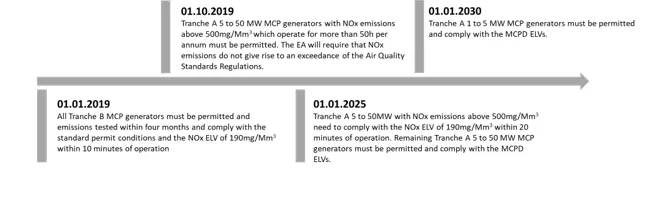Is your business affected by the Medium Combustion Plant Directive (MCPD)? Learn what it means, who it impacts, and how to stay compliant with emissions regulations.
Before detailing the requirements of the Medium Combustion Plant Directive, it is important to define combustion plant. A combustion plant is any technical apparatus in which fuels are oxidised in order to use the heat generated it will cover boilers, turbines and engines (European Commission 2019).
The Medium Combustion Plant Directive (MCPD, Directive 2015/2193/EU) was transposed into UK legislation via the following amendments:
- England and Wales: Environmental Permitting (England and Wales) (Amendment) Regulations 2018;
- Northern Ireland: Pollution Prevention and Control (Industrial Emissions) (Amendment) Regulations (Northern Ireland) 2018; and
- Scotland: Pollution Prevention and Control (Scotland) Amendment Regulations 2017.
The MCPD regulates pollutant emissions that are a result of the combustion of fuels in Medium Combustion Plants. Medium Combustion Plants, or MCPs, are plant with a rated thermal input greater than or equal to 1MWth and less than 50MWth. Specified Generators are a subcategory of MCPs that generate electricity for more than 50 hours per annum (including any testing required) or export electricity to the grid.
Requirements of the MCPD (England and Wales)
Pollutant emissions regulated under the MCPD are oxides of nitrogen (NOx), sulphur dioxide (SO2), and dust in order to reduce harm to environment, human health and assist in meeting legally-binding emission reduction targets. Either a standard rules or bespoke permit will be required for new and existing MCPs as well as Tranche A and B Specified Generators. New MCPs, existing MCPs, Tranche A and Tranche B are defined as:
- MCPs:
- New: any plant commencing operation for the first time after 20 December 2018
- Existing: any plant which commenced operation before 20 December 2018
- Specified Generators:
- Tranche A: generators that were in operation before 1st December 2016 or benefit from capacity agreements from the 2014 and 2015 capacity market auctions or generators <1MWth with capacity agreements from the 2016 capacity market auction
- Tranche B: specified generators that do not fall within the Tranche A category as described above
When you must aggregate (new MCPs only)
You can only aggregate new MCPs. Aggregating separate discharge points, for example stacks, can improve dispersion.
Form a single MCP by adding together the rated thermal input of 2 or more separate new plant on your site that discharge the waste gas through a common windshield.
A common windshield is a shared structure or stack and it may contain one or more flues.
Do not count any new units measuring less than 1MWth.
If, after aggregation, the combined thermal input is greater than 50MWth, you should check the rules for large combustion plant.
Operators must not avoid aggregation:
- by separating discharge points
- to minimise costs


There are some exemptions based on requirements for environmental permits and ELVs. A detailed list of these exemptions can be found on the Environment Agency’s Guidance on MCPs and Specified Generators. The NI and Scottish regulations are slightly different to the above, but guidance can be found here:
- Northern Ireland Department of Agriculture, Environment and Rural Affairs Guidance
- Scottish Environment Protection Agency Guidance
Are you responsible for a combustion plant? Did you already know about the MCPD?







